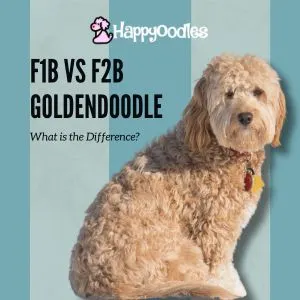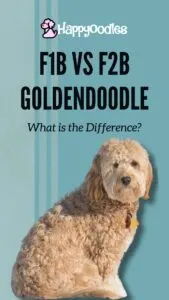If you’re looking for a Goldendoodle, you’ve likely come across an array of Doodle classifications that might seem confusing at first glance: F1 Goldendoodle, F1B Goldendoodle, F2 Goldendoodle, F2B Goldendoodle, and even the F3 Goldendoodle (aka a multi-generation doodle.)
These classifications are more than just alphanumeric codes; they represent the genetic makeup and breeding history of these adorable dogs. But what do all these terms mean? And more importantly, how do they affect your decision on which Goldendoodle is the right fit for you?
Understanding the distinctions between these various types of Goldendoodles is crucial for prospective owners. Each classification has its unique characteristics, from coat type and grooming needs to temperament and health considerations.
However, reviewing all the specifics of each classification could turn into a lengthy post. Therefore, in this post, we’re going to focus on the F1B Goldendoodle vs the F2B Goldendoodle. We’ll explore what it means to be an F1B vs F2B Goldendoodle, how they compare to each other and why one might be a more suitable choice for you than the other.

Understanding Goldendoodle Generations
Let’s start with an overview of what the various Goldendoodle Generations (aka classifications) mean.
When it comes to doodle breeding, the “F” in the generation names stands for “Filial,” referring to the offspring resulting from the crossbreeding of two different purebred dogs—in this case, the Golden Retriever and the Poodle.
Each subsequent letter and number combination reveals specific details about the Goldendoodle’s lineage. Here’s what each term means:
F1 Goldendoodle
- Definition: First Generation Goldendoodle.
- Genetic Composition: 50% Golden Retriever, 50% Poodle.
- Characteristics: F1 Goldendoodles tend to have a variety of coat types, including wavy and curly, and are often considered to have a moderate shedding level. They benefit from the hybrid vigor associated with first-generation crosses, potentially leading to better health.
F1B Goldendoodle
- Definition: First Generation Backcross Goldendoodle.
- Genetic Composition: 75% Poodle, 25% Golden Retriever.
- Characteristics: An F1B Goldendoodle is the result of breeding an F1 Goldendoodle back to a purebred Poodle. This generation is popular for its significantly reduced shedding, making it a better option for families with allergies. They often have curlier coats and retain the intelligence and friendly nature of both parent breeds.
F2 Goldendoodle
- Definition: Second Generation Goldendoodle.
- Genetic Composition: 50% Golden Retriever, 50% Poodle (but from two F1 Goldendoodle parents).
- Characteristics: This generation can have a wide range of coat types and shedding levels, similar to the F1s. Their temperament can also vary widely, making their characteristics less predictable than the F1 or F1B generations.
F2B Goldendoodle
- Definition: Second Generation Backcross Goldendoodle.
- Genetic Composition: 62.5% Poodle, 37.5% Golden Retriever.
- Characteristics: F2B Goldendoodles result from breeding an F2 Goldendoodle back to a purebred Poodle. This generation aims to maintain the desirable low-shedding coat quality of the F1B while introducing a bit more genetic diversity than the F1B generation. They often have a good balance of the friendly and intelligent traits of their parent breeds, with a slightly higher predictability in coat type and temperament than F2 Goldendoodles.
Note: For the purpose of this article we used a Poodle in the crossback scenarios as this is the most common practice. However, breeders might also choose to use a Golden Retriever as the cross back instead of a Poodle. This approach can enhance or maintain specific traits, such as the Golden Retriever’s friendly demeanor and physical characteristics. It can also change how hypoallergenic the dog is and its shedding levels. It’s best to ask your breeder about specific breeding practices.

F1B vs F2B Goldendoodle Overviews
F1B Goldendoodle Overview
The F1B Goldendoodle is a wonderful blend that leans more towards the Poodle’s side, with its genetic composition being approximately 75% Poodle and 25% Golden Retriever. This particular mix hopefully inherits the best traits from both breeds and also offers a unique set of characteristics.
Key Characteristics
- Appearance: F1B Goldendoodles tend to have a more curly coat, resembling the Poodle’s hypoallergenic fur, which is a big plus for allergy sufferers. Their size can vary, largely dependent on the Poodle size used in breeding (standard, miniature, or toy).
- Temperament: They inherit the intelligence and friendliness of both parent breeds. Known for their gentle nature, they make excellent companions, and are great with children and other pets.
- Energy Levels: Moderate to high energy levels are typical, requiring regular exercise to stay healthy and happy. Activities can range from walks and playtime in the yard to more engaging exercises like swimming.
- Grooming: Their coat requires regular grooming to prevent matting and to keep them looking their best. Professional grooming every 6-8 weeks, along with daily to weekly brushing, is recommended.
Health Considerations
While the F1B Goldendoodle benefits from hybrid vigor, making them generally healthier than their purebred counterparts, they can still inherit some genetic health issues from the Poodle and Golden Retriever lines. It’s important for prospective owners to check health clearances for conditions like hip dysplasia, von Willebrand’s disease, and eye conditions.
F2B Goldendoodle Overview
An F2B Goldendoodle represents a progression in Goldendoodle breeding, embodying a slightly more balanced mix with an approximate genetic composition of 62.5% Poodle and 37.5% Golden Retriever. This generation is created by crossing an F2 Goldendoodle (itself a second-generation doodle, with both parents being F1 Goldendoodles) with a purebred Poodle. This blend aims to preserve the Poodle’s hypoallergenic qualities while still capturing the Golden Retriever’s amiable nature.
Key Characteristics
- Appearance: The F2B Goldendoodles often showcase a coat that strikes a balance between the wavy fur of the Golden Retriever and the curly, hypoallergenic coat of the Poodle. Their looks can vary, with a range of colors and coat types more predictable than the F2, but with a bit more variety than the F1B.
- Temperament: Known for their intelligence, sociability, and affectionate nature, F2B Goldendoodles make excellent family pets. They generally inherit the easygoing nature of the Golden Retriever and the smarts of the Poodle.
- Energy Levels: These dogs typically exhibit moderate to high energy levels and thrive on engagement, play, and exercise. They’re adaptable to various types of physical activities, from leisurely walks to more vigorous play sessions.
- Grooming: Similar to the F1B, the F2B Goldendoodle requires regular grooming to maintain their coat’s condition and to minimize shedding. Their grooming needs might be slightly less demanding than the F1B’s, but consistent care is essential.
Health Considerations
The F2B generation can still enjoy some of the benefits of hybrid vigor, which can contribute to overall health and longevity. However, being proactive about health screenings for common issues in Poodles and Golden Retrievers, such as hip dysplasia and cardiac issues, remains important for potential owners.
Comparing the F1B vs F2B Goldendoodle
When comparing the F1B vs F2B Goldendoodle, understanding their similarities and differences can help you decide which generation might be the perfect match for you. Let’s take a look at how they compare:
Coat Types and Grooming Needs
- F1B Goldendoodles typically have a curly coat that closely resembles that of a Poodle, making them highly desirable for their low-shedding properties. This type of coat requires regular grooming to prevent matting and tangling, including daily to weekly brushing and professional grooming every 6-8 weeks.
- F2B Goldendoodles also have a high likelihood of sporting a curly or wavy coat due to their 62.5% Poodle genetics, presenting similar low-shedding characteristics. Their grooming needs are much like the F1B’s, with a consistent grooming schedule necessary to keep their coat in top condition.
Allergy Friendliness
Both F1B and F2B Goldendoodles are considered more allergy-friendly than F1 or F2 generations, thanks to their higher Poodle genetic makeup. The F1B, with its approximately 75% Poodle genetics, might have a slight edge in being hypoallergenic. However, F2B Goldendoodles can also be a great choice for those with mild to moderate allergies.
But remember that no dog is completely allergy free. If this is a concern for you, make sure to spend time with the dog you plan to get before making the commitment.
Temperament and Behavior Differences
- F1B Goldendoodles are known for their intelligent, friendly, and affectionate nature. They are generally easy to train due to their high intelligence inherited from both the Golden Retriever and Poodle lines.
- F2B Goldendoodles share many of the same temperament traits as F1B Goldendoodles, including being intelligent, sociable, and family-friendly. The slight difference in their genetic makeup may introduce a bit more variability in temperament, with some F2Bs possibly inheriting a stronger trait from the Golden Retriever side or the Poodle side, but overall, they are quite similar in behavior.
Exercise and Space Requirements
Both F1B and F2B Goldendoodles have moderate to high energy levels and require regular exercise to stay healthy and happy. They enjoy a mix of physical activities like walking, running, and swimming, alongside mental stimulation through training and playing games.
While neither requires an excessively large living space, they do best in environments where they have room to play and explore. A home with a yard is ideal, but they can adapt to apartment living as long as their exercise needs are met through regular outdoor activities.
Cost Comparison
Both the F1B Goldendoodle and F2B Goldendoodle tend to be priced higher on average compared to many other Goldendoodle generations. This is largely due to their popularity for being considered more hypoallergenic than their F1 counterparts.
Availability
- F1B Goldendoodles are widely sought after, which means breeders are more likely to focus on producing them. This high demand can make them more readily available, but it also means you might end up on a waiting list, especially if you’re looking for a puppy from a reputable breeder who conducts health screenings and follows responsible breeding practices.
- F2B Goldendoodles may be slightly less common than F1Bs. Since F2Bs result from breeding an F2 Goldendoodle back to a Poodle, and considering the variability in F2 coats and temperaments, breeders might produce them less frequently. However, this does not mean they are rare; it just might require a bit more research and patience to find a breeder who specializes in F2B Goldendoodles.
Choosing Between the F1B vs F2B Goldendoodle
Choosing the perfect Goldendoodle for your family comes down to matching a dog’s characteristics with your lifestyle, preferences, and needs. If allergies are a concern, an F1B Goldendoodle, with its higher Poodle genetics, might be more suitable. However, F2B Goldendoodles can be good for families with mild to moderate allergies.
Consider your family’s activity level and living situation; both F1B and F2B Goldendoodles are adaptable and active, but they do require regular exercise and grooming to stay healthy and happy. Cost is also a factor, as prices can vary based on the breeder and generation, with F1B puppies often being pricier due to their popularity.
When deciding, it’s essential to research breeders thoroughly, looking for those who provide health clearances and support in choosing a puppy that fits your lifestyle.
Ultimately, whether you choose an F1B or F2B Goldendoodle, both generations offer immense love, joy, and companionship, making them wonderful additions to any home.
